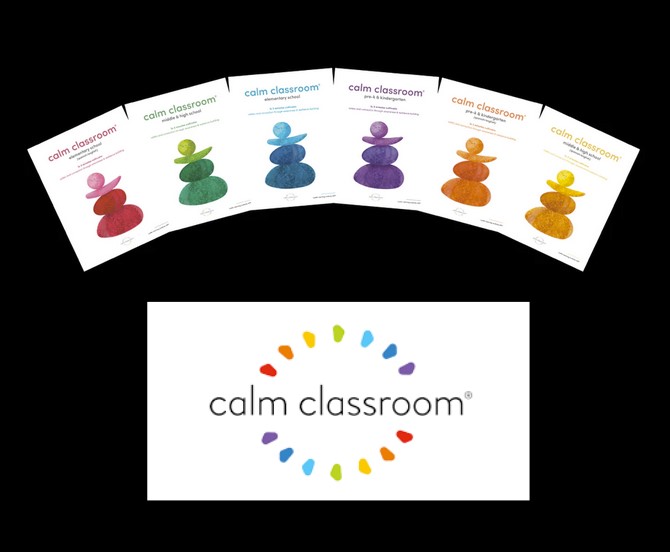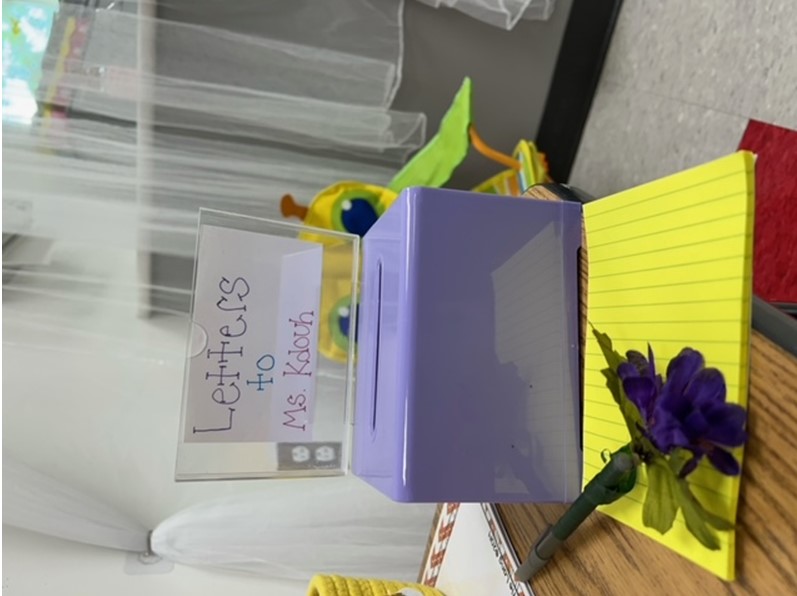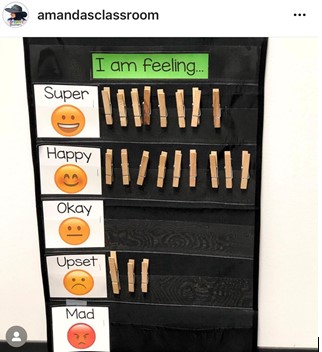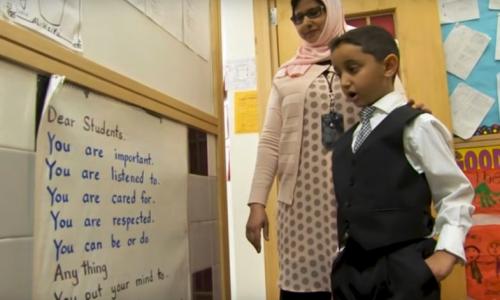One day, as her students were returning to the classroom from a specials class, first-grade teacher Amanda Tokko noticed that a little boy was upset. She asked him if he wanted to talk. He shook his head and walked over to the calm corner that Ms. Tokko had created. It included a hanging canopy, a box of fidget toys, and a book called "I Know What to Do When I Am Feeling..."
The boy looked through the book until he found the page about frustration. After looking at the page for a few moments, he went back to Ms. Tokko and told her he was ready to talk about what had been upsetting him. After a brief conversation, the boy had calmed down and returned to their class activity.
At Salina Elementary School in Dearborn, Michigan, these small yet significant moments are happening in classrooms throughout the building thanks to the school's deep commitment to social and emotional learning (SEL).
Salina Elementary is a Title I school whose student population is mostly English language learners (ELLs), many of whom are newcomer immigrants from the war-torn country of Yemen. Since numerous students in the Salina community have experienced family separation, trauma, and hardship related to the war or displacement, the school has long prioritized strong social and emotional supports for its students informed by training in trauma-informed practice.
When the COVID-19 pandemic hit, however, the school quickly recognized that they needed to further intensify their focus on SEL. Their efforts have yielded school-wide positive results in terms of students' ability to regulate emotions, manage conflict, and focus on their learning.
We had the opportunity to learn more about Salina's approach to SEL through surveys and interviews with the school staff and leaders. The following article highlights some of the reasons SEL is working at Salina and the staff's takeaways about why it matters. You can learn more about Salina from our documentary about the school and related resources below.
School-wide Initiatives
As the Salina staff has embarked on a deeper exploration of SEL within their own professional learning, they have scaled up SEL work they were already doing before the pandemic, integrating it into the classroom more intentionally, while also focusing on the social and emotional well-being of families and staff. This work has included the following:
1. Staff training
School leaders have ensured that the staff has had extensive training related to social-emotional learning, which continues on an ongoing basis. One of the key leaders of this effort has been the school social worker, who has led regularly scheduled professional development sessions on topics such as trauma-informed instruction. This not only provides important information for staff; it also fosters more collaboration between the social worker and teachers.
Principal Sue Stanley writes, "In terms of the school social worker and collaboration, it boils down to a school-wide practice of -- not just a belief in -- collaboration. When true collaboration is present, it is natural for staff to reach out to the social worker for any questions or concerns. The social worker must be viewed as a leader...If the school leader sees it as a priority, the staff will as well." Ms. Stanley notes that the social worker is also part of the school's Multi-Tiered Support System (MTSS) meetings each week where teachers bring students for discussion and support.
2. Calm Classroom
 Before COVID-19, the school had implemented the Calm Classroom program based on the recommendation of the social worker, which includes a curriculum that has weekly lessons and teaches students calming practices such as guided meditations. Principal Stanley writes, "Teachers and students start their day with short scenarios, calm breathing and classroom affirmations." Ms. Stanley notes that laying the groundwork around trauma and SEL can lead to meaningful conversations about why the Calm Classroom is important. "It's not hard to implement and takes just a few minutes a day. The results are so powerful," she says.
Before COVID-19, the school had implemented the Calm Classroom program based on the recommendation of the social worker, which includes a curriculum that has weekly lessons and teaches students calming practices such as guided meditations. Principal Stanley writes, "Teachers and students start their day with short scenarios, calm breathing and classroom affirmations." Ms. Stanley notes that laying the groundwork around trauma and SEL can lead to meaningful conversations about why the Calm Classroom is important. "It's not hard to implement and takes just a few minutes a day. The results are so powerful," she says.
Ms. Tokko notes that she and her class do Calm Classroom exercises multiple times a day, including at times when the class needs to settle down. She and her students have some favorites, and she does the exercises with the students. She has noticed that the impacts of this program are extending home as well -- her students are teaching their families how to do some of the breathing exercises at home.
Teacher Diana Goodhue mentions the importance of ensuring that all students, including her ELLs, fully understand the activities before starting them. "I do the Calm Classroom activities with them so they see me model it," she says. "Then we stick with the same Calm Classroom for a week at a time so that they get comfortable with it."
3. Books and read-alouds
The school has also made reading a priority in their SEL work. For example, Classroom Book-A-Day is a school initiative that promotes read-alouds in the classroom. Many of the books that teachers read have to do with SEL. Ms. Tokko writes, "I like to read a book in the morning during morning meeting and after lunch to calm students down." Some of the books that Ms. Tokko has used are included in our SEL booklist, and others are listed at the end of the article.
has also made reading a priority in their SEL work. For example, Classroom Book-A-Day is a school initiative that promotes read-alouds in the classroom. Many of the books that teachers read have to do with SEL. Ms. Tokko writes, "I like to read a book in the morning during morning meeting and after lunch to calm students down." Some of the books that Ms. Tokko has used are included in our SEL booklist, and others are listed at the end of the article.
In addition, the school participates in an initiative called "One School One Book," in which all students read a chapter book as a school. For example, when the school read Wishtree by Katherine Applegate, which is the story about an immigrant girl who moves into a town that is not welcoming, the school planted their own Wishtree and did a dedication with their favorite quote: When things get tough, "stand tall and reach deep." The students then went into the neighborhood and left messages on the doors of their neighbors, focusing on the theme "our differences make beautiful gifts" for the school year.
4. Family engagement
The school also continues to provide regular, ongoing communication in families' languages about things that are happening in class, how families can help their students, and supports such as social services. The school also holds regular family meetings where families have a chance to share their questions and concerns and talk about any challenges they are facing. Just as importantly, the school has figured out how to make its family outreach culturally responsive and align it to families' preferences. For example, in the Salina community, many of the mothers prefer to be in groups that only include other women, and so the school plans family events accordingly.
Classroom Environment
Another priority for the staff is building relationships with students and making them feel welcome. "I try my best to help students build confidence in themselves," says Ms. Tokko. "Our classroom really is a family." Here are some ways the staff is creating a nurturing environment for students.
5. Creating a welcoming classroom
The staff have placed a strong emphasis on creating a welcoming environment, posting notes of encouragement around the school, and getting to know students' interests. For example, teacher Welaya Alhaiki, pictured at the top of this article, has posted the following sign outside of her room:
Dear Students,
You are important.
You are listened to.
You are cared for.
You are respected.
You can be or do
Anything
You put your mind to.
I support you.
You are in a safe place!
Love, Ms. Alhaiki
Other signs around the school promote a sense of community while encouraging students to adopt a growth mindset. Positive messages are almost always in view of students throughout the building.
6. Calm corners
In addition, the leadership team has provided each teacher a small budget to create a calm corner in their classroom. Items include a canopy or tent, a few fidgets, and a special book, like the one Ms. Tokko mentioned above. Teacher Rebecca Rosemary uses her calm-down tent "for students having a hard time with emotions," while Ms. Goodhue reiterates the importance of making sure students know how to use the calm corner. "I demonstrate everything they have to use in the Calm Corner," she says.
Ms. Stanley notes that she used Title funds for the calm corner supplies, but that other parent clubs, program budgets, or SEL projects could also support this kind of initiative. The investment is well-worth it, says Ms. Stanley, especially when compared to what the schools spends on supplies.
Classroom Strategies
At the core of these efforts are the daily strategies that teachers are using to check in with students and help students build their emotional vocabulary. These efforts are integrated throughout the day and are part of students' routines so that they know what to expect and how to ask for help if needed.
7. Daily check-ins
 One strategy the staff has been using regularly is student check-ins. These may be through individual conversations or circle time. Ms. Tokko also uses a letter box where students can leave a private note about how they are feeling. Ms. Kdouh does the same. She says, "I have this 'mailbox' in my calm corner with a pack of large sticky notes and a special pen where students who come to the calm corner can draw/write about how they’re feeling or why they came to the calm corner. Students fold their note and slip it into my letter box. I check it daily before leaving school and it is locked so no one else can open it except me. Students are aware of this and share their feelings without feeling embarrassed or afraid that a peer might see it. After a student drops a letter in there, I unlock it and remove it so I can help them as soon as possible."
One strategy the staff has been using regularly is student check-ins. These may be through individual conversations or circle time. Ms. Tokko also uses a letter box where students can leave a private note about how they are feeling. Ms. Kdouh does the same. She says, "I have this 'mailbox' in my calm corner with a pack of large sticky notes and a special pen where students who come to the calm corner can draw/write about how they’re feeling or why they came to the calm corner. Students fold their note and slip it into my letter box. I check it daily before leaving school and it is locked so no one else can open it except me. Students are aware of this and share their feelings without feeling embarrassed or afraid that a peer might see it. After a student drops a letter in there, I unlock it and remove it so I can help them as soon as possible."
8. Building emotional vocabulary
 These practices have also supported creative ways to increase students' communication around emotions and calming practices. For example, the teachers talk about what different feelings might feel like and have set up different ways for students to identify their feelings on a certain day. Ms. Tokko writes, "Students complete this feelings chart (pictured to the left) in the morning and after lunch to let me know how they’re feeling and how I can help. The clothespins have their student numbers on the other side but are flipped over for privacy." This way, Ms. Tokko can check in with the students who indicate they are upset.
These practices have also supported creative ways to increase students' communication around emotions and calming practices. For example, the teachers talk about what different feelings might feel like and have set up different ways for students to identify their feelings on a certain day. Ms. Tokko writes, "Students complete this feelings chart (pictured to the left) in the morning and after lunch to let me know how they’re feeling and how I can help. The clothespins have their student numbers on the other side but are flipped over for privacy." This way, Ms. Tokko can check in with the students who indicate they are upset.
The teachers also use commonly-used ELL scaffolds to support these resources and strategies. Kindergarten teacher Emily Wagner writes, "We use detailed visuals for emotions and calm-down practices so students know how to follow without knowing the words."
In addition, the social worker also provides SEL lessons to students and teachers look for way to make these connections to curriculum as well.
Celebrations
9. Celebrating successes
The school is also mindful of celebrating successes within the classroom and more broadly in the school. For example, Ms. Tokko has encouraged her students to clap for each other when they achieve positive accomplishments, no matter how small. She writes, "Students are always clapping for their peers' successes by themselves and using positive words in our classroom." (And she says that they clap for any guest who enters the classroom!) Ms. Stanley also notes that SEL goals and achievements will now be included in the school's Celebration Wall in the front office.
10. Celebrating families in the classroom
In addition, the staff at Salina are also actively partnering with families around SEL activities in the classroom. Some of their efforts include the following ideas:
- Ms. Kdouh has created a family/student picture wall in her classroom.
- Ms. Goodhue gives each student a "spotlight week" where they take home a poster and a pack of crayons to fill out about themselves. Ms. Goodhue writes, "Their poster is put in the hall for the week and they get to share it with the class. This gives them a chance to share things that are important to them and their family. It also gives parents a chance to help."
The school is also brainstorming ways to highlight these activities as part of family engagement this year so that families can continue to support SEL at home.
SEL in Action: Photos from Salina
Impacts of SEL and Lessons Learned
When asked what the impact of these efforts have had on students, teachers' responses are overwhelmingly positive. Here are what the teachers who completed our survey had to say:
- Ms. Kdouh: "Students enjoy coming to school and don’t feel uncomfortable or scared."
- Ms. Goodhue: "Many students have taken charge of their own mental health, taking breaks when needed, asking for help when they need to, and working on communicating with friends when there are issues."
- Ms. Wagner: "Student self-regulation has improved, and students are able to guide themselves through calming practices. Students think more deeply about their emotional state and can identify ways to help themselves feel better."
- Ms. Rosemary: "I am seeing fewer abrupt meltdowns in the classroom, and students are able to have more of a discussion when they are having strong feelings."
- Ms. Tokko: "I have been able to instill empathy and compassion in our classroom. Students also have respect for me as well as their peers because I have showed them that I have respect for them as well. Students are more eager to learn and listen....and I try my best to help students build confidence in themselves."
- Principal Stanley: "I am amazed at the gains we are making in behavior...The overall impact on the SEL focus is the safe space that is created in our school. This space is here for everyone. The comment that everyone makes when they walk into Salina is that it has such beautiful energy. That can only be achieved by everyone in the building feeling that way. The positive energy is there because everyone, both big and small are emitting it.
We also asked teachers to share their lessons learned about SEL. Here's what they shared:
- Ms. Kdouh: "There is no one size fits all. All students convey emotions in a different way. This is why I use more than one SEL strategy."
- Ms. Rosemary: "The importance of how SEL can help within other aspects of the school day."
- Ms. Wagner: "Students are very responsive to routine, and SEL can easily fit into the academic routine."
- Ms. Tokko: "Being calm in the classroom goes a long way. I have a student who is sensitive to loud noises. Incorporating Calm Classroom and creating a stress-free environment is crucial. Also, building a classroom community full of respect, trust, and confidence helps academics. SEL is the foundation...Students need social and emotional learning in order to succeed."
- Ms. Goodhue: "It doesn't take a lot of effort to make it work. A little bit goes a long way to helping a lot of kids. You can grow as you go."
Support from Leadership
As noted throughout the article, this strong emphasis on SEL is made possible through direct and ongoing support from the school leadership team. From the teachers' perspectives, they shared that direct feedback, training, and dedicated time and resources for SEL were key ways in which school leaders were supporting their efforts in SEL.
The staff also note that the leaders have:
- Shown appreciation and emotional support for teachers and students
- Given staff opportunities to show their appreciation for each other
- Provided opportunities for staff to build community through activities such as sharing a favorite photo with colleagues
- Modeled the practices that are highlighted
- Supported collaboration among team members and with social workers
- "Tried to keep up staff morale even through a rough school year with the pandemic"
Ms. Tokko writes, "Our principal is like our cheerleader. She is always there for the teachers and staff and helping us get through the toughest times, especially during this pandemic."
For her part, Ms. Stanley knows that what she does matters, not only in terms of the support and resources she provides but also in terms of her example and priorities. She writes, "We will collectively discuss how to move students forward rather than 'catching up.' As a leader, I know I must model that behavior for staff as well. Teachers feel continual pressure to fit all the academics in.
"While we understand students cannot learn until they feel safe and connected, that takes time. I will continually be the reassurer and voice for that. I will commit to creating that same type of environment for them through thoughtful and intentional planning. And as their leader, I will be standing shoulder to shoulder with them and reminding them of this every step of the way."
Videos
Principal Sue Stanley: Why creating a calm, safe environment in schools matters
Principal Sue Stanley: When loud noises in school cause post-traumatic stress
A warm welcome for immigrant families in the front office
Norieah Ahmed, the Child Accounting Secretary at Salina Elementary School in Dearborn, MI, talks about her role in welcoming newcomer immigrant families to the school from the moment they walk in the door.
Looking at the whole child: Conversations with an award-winning social worker
Meet Dr. Rola Bazzi-Gates, a special education coordinator for Dearborn Public Schools and Michigan's 2016 Social Worker of the Year. Learn how her personal experience living through conflict helped prepare her to support students and families today.


 The memorable stories in our
The memorable stories in our 





Add new comment